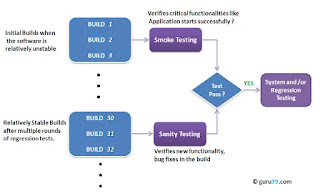Difference between regression, sanity and smoke tests
Regression testing, sanity testing, and smoke testing are different types of software testing methodologies, each serving a specific purpose in the software development life cycle. Here's a brief explanation of each:
Regression Testing:
- Purpose: The primary purpose of regression testing is to ensure that new changes or modifications to the software do not adversely affect existing functionalities.
- Scope: It involves testing the entire application or a significant part of it to verify that the existing features still work as intended after the introduction of new code.
- Frequency: It is typically performed after each code change or addition to the software to catch any unintended side effects on existing functionalities.
- Automation: Regression testing is often automated to efficiently validate the system against a set of predefined test cases.
- Sanity Testing:
- Purpose: Sanity testing, also known as build verification testing or confidence testing, is performed to quickly verify that the specific functionalities or components of the software are working correctly after a build or release.
- Scope: It focuses on a narrow set of functionalities or modules, rather than the entire application.
- Frequency: It is usually conducted during the early stages of the development cycle or after bug fixes to ensure that the critical functionalities are intact.
- Automation: While automation can be used for sanity testing, it is often performed manually due to its targeted and quick nature.
- Smoke Testing:
- Purpose: Smoke testing is a preliminary test performed to check if the major functionalities of the software are working correctly. It helps ensure that the software build is stable enough for more in-depth testing.
- Scope: Like sanity testing, smoke testing focuses on a broad level, covering the basic and critical features of the application.
- Frequency: It is typically executed before more comprehensive testing phases, such as regression testing, to identify major issues early in the development process.
- Automation: Smoke testing is often automated, especially in continuous integration and continuous delivery (CI/CD) environments, to quickly assess the build's viability.
In summary, while regression testing aims to validate the overall system after changes, sanity testing focuses on specific functionalities, and smoke testing provides a quick assessment of the software build's basic stability. All three types of testing are essential in ensuring the quality and reliability of software applications.
Regression Testing:
- Purpose: The primary purpose of regression testing is to ensure that new changes or modifications to the software do not adversely affect existing functionalities.
- Scope: It involves testing the entire application or a significant part of it to verify that the existing features still work as intended after the introduction of new code.
- Frequency: It is typically performed after each code change or addition to the software to catch any unintended side effects on existing functionalities.
- Automation: Regression testing is often automated to efficiently validate the system against a set of predefined test cases.
- Sanity Testing:
- Purpose: Sanity testing, also known as build verification testing or confidence testing, is performed to quickly verify that the specific functionalities or components of the software are working correctly after a build or release.
- Scope: It focuses on a narrow set of functionalities or modules, rather than the entire application.
- Frequency: It is usually conducted during the early stages of the development cycle or after bug fixes to ensure that the critical functionalities are intact.
- Automation: While automation can be used for sanity testing, it is often performed manually due to its targeted and quick nature.
- Smoke Testing:
- Purpose: Smoke testing is a preliminary test performed to check if the major functionalities of the software are working correctly. It helps ensure that the software build is stable enough for more in-depth testing.
- Scope: Like sanity testing, smoke testing focuses on a broad level, covering the basic and critical features of the application.
- Frequency: It is typically executed before more comprehensive testing phases, such as regression testing, to identify major issues early in the development process.
- Automation: Smoke testing is often automated, especially in continuous integration and continuous delivery (CI/CD) environments, to quickly assess the build's viability.
In summary, while regression testing aims to validate the overall system after changes, sanity testing focuses on specific functionalities, and smoke testing provides a quick assessment of the software build's basic stability. All three types of testing are essential in ensuring the quality and reliability of software applications.



Comments
Post a Comment